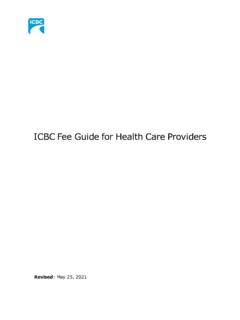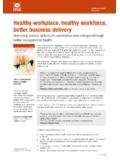Transcription of Total Hip Replacement - Gold Coast Health | Always Care
1 Total Hip Replacement Pre and post-operative patient guide 2 What is a Total Hip Replacement ? Total Hip Replacements are performed for people who have severe osteoarthritis that is making daily activities difficult and is no longer responding to other treatments. A Total Hip Replacement involves the surgical removal and Replacement of the damaged femoral head and acetabulum of the hip joint with a prosthetic implant. Total Hip Replacements can be performed through different surgical approaches based on the decision of the Orthopaedic Surgeon. Depending on the type of surgical approach, different wound areas and post-operative precautions will apply. All joint replacements are major, planned 1-2 hour surgeries requiring admission to hospital, anaesthesia and post-operative hospital recovery. The recovery process begins immediately post-operation and is guided by Medical, Nursing and Allied Health Teams to help people improve their function and ability to participate in daily activities.
2 3 Hip precautions Following surgery, the muscles and soft tissues around the hip are weaker and unable to stabilise the hip as usual. Because of this, there are recommended hip precautions post-operatively to limit certain movements and positions that increase the risk of hip joint damage and dislocation. Different hip precautions will apply based on the surgical approach taken. The Orthopaedic team will provide advice on how long to follow the recommended hip precautions. Anterior approach Not all surgeons recommend the same precautions for an anterior approach. The Physiotherapist will clarify the correct hip precautions on Day 1. Do not excessively rotate leg Do not lift leg straight up in the air inwards or outwards Do not force leg backwards 4 Hip precautions Posterior approach Do not bend hip past 90 degrees Activities that may place the hip past 90 degrees include: reaching towards the ground, picking things up, and sitting on low surfaces.
3 Do not cross legs whilst sitting, lying or standing Do not excessively rotate leg inwards or outwards 5 Patient journey The order and attendance of appointments and services may vary depending on scheduling and individual patient circumstances. 6 Checklists (please tick off completion steps) Pre-a dmission Attend Pre-Admission Clinic Attend Education Class Community Home Visit Implement Home Visit recommendations Organise any recommended equipment Attend Pre-Admission Check Stock fridge and prepare meals for return home Organise for family or friends to pick-up and assist on discharge What to bring Usual mobility aid with name marked (if applicable) All current medications Toiletries Well fitting, closed in shoes Loose fitting clothes Hearing aids & glasses This patient guide Typical Mobility Aid 7 Personal and practical considerations When preparing for surgery it is important to plan ahead to reduce any anxiety or impact during the recovery process.
4 Considerations include: Managing financial impacts Sick Leave & Superannuation Income Protection: For further information on eligibility contract the HR or Payroll of your employment. WorkCover QLD: If the surgery performed is related to a workplace injury, work cover may apply. To confirm eligibility contact WorkCover on 1300 362 128, or visit Centrelink Sickness Allowance: To confirm eligibility, contact Centrelink on 132 717 or visit Community care arrangements If assistance with domestic tasks such as meal preparation, cleaning, transport or personal care will be required on return home, it is important to organise support from family, friends and/or community services. For information on accessing aged care services (aged 65 and over), call My Aged Care on 1800 200 422 or visit Carers For patients who are carers for someone at home, it is important to make arrangements prior to hospital admission.
5 If emergency respite care is required, call the Commonwealth Respite and Carelink Centre on 1800 052 222, or 1800 059 059 outside of business hours. Advanced Care Planning For persons of all ages it is important to consider appointing and completing an Enduring Power of Attorney (EPOA) and/or an Advanced Health Directive (AHD). For further information contact the Public Trust on 1300 360 044, visit , or contact your Solicitor. 8 Pain management Nerve block Nerve blocks involve using a local anaesthetic agent to numb the targeted area. The affected leg may feel numb after surgery, but feeling will return quickly as the block wears off. It is important to ask for pain relief as the block starts to wear off. Staff should be informed if the numbness remains. Patient-Controlled Analgesia (PCA) A PCA is a device that contains strong pain medication. By pushing the button that is attached to the device, pain medication is delivered directly into the bloodstream.
6 A PCA allows for patients to control their own pain relief. The device has inbuilt safety mechanisms to prevent overdoses. Oral pain relief Oral analgesics (tablets, capsules or liquid) will usually be provided post-operatively to assist with pain relief. In addition to analgesics like Paracetamol and anti-inflammatory medications, patients can also request stronger, short-acting pain tablets that can take up to 30-minutes to start working. It is advisable to take pain medications prior to commencing mobility and exercise. Long-acting pain tablets may also be prescribed for a short period of time following surgery. Side effects Some pain medication can cause side effects such as nausea, vomiting, itchiness, drowsiness and constipation. Patients are asked to report any side effects they are experiencing to nursing staff. 9 Day zero After the operation, patients are transported to the Orthopaedic or Surgical ward.
7 It is common post-operatively to have multiple attachments on the body, such as: oxygen nasal prongs, blood pressure cuffs, intravenous drips and in- dwelling catheters. Deep breathing and circulation exercises Post-operatively it is very important to reduce the risk of developing blood clots by performing deep breathing & circulation exercises every hour. Ankle pumps Static contractions Move feet up and down Tense thigh and bottom muscles for a short duration and release slowly Deep breathing With or without the Incentive Spirometer, breathe slowly and deeply into bottom of lungs, relax and exhale out slowly 10 Day 0 Mobilise with Physiotherapist (if requested by surgeon) Day 1 Mobilise with Physiotherapist Perform prescribed exercises Occupational Therapist review Have a shower Sit out in armchair Continue to ensure pain relief is adequate, and that self-directed exercises are performed as instructed by the Physiotherapist.
8 Day 2 and 3 progress mobility with Physiotherapist Stairs Assessment (if required) Perform prescribed exercises Occupational Therapist review (if not performed Day 1) Sit out in armchair Continue to perform self-directed exercises and mobilise as instructed by the Physiotherapist. 11 physiotherapy exercises Perform exercises as instructed by the Physiotherapist to promote the recovery of strength and movement following your joint Replacement . Hip abduction/adduction Heel slide Lying flat, lift and move your leg out Lying flat, slide your heel to the side and then back towards your bottom Inner range quad Bridge Keep knee resting on towel roll, Push through feet to lift lift foot to straighten your knee hips off bed 12 Advanced exercises Perform these more advanced standing exercises only when instructed or advised by the Physiotherapist.
9 All standing exercises should be performed safely whilst holding onto a supportive surface. Hip abduction Lift leg out to the side, and then back slowly Hip flexion Lift knee upwards, and lower back down slowly Hip extension Keeping body straight, lift leg backwards and bring back slowly 13 Advanced exercises Perform these more advanced standing exercises only when instructed or advised by the Physiotherapist. All standing exercises should be performed safely whilst holding onto a supportive surface. Heel raise Stand onto tip-toes Mini-squat Slowly bend both knees and stick bottom out Sit to stand Lean forwards, push through both heels to stand up 14 Discharge checklist Able to mobilise safely with mobility aid Able to negotiate stairs safely (if applicable) Able to get in and out of bed Performing exercise program independently Home services organised to assist with self-cares (if required) Essential home equipment organised Recommended mobility aid purchased/hired (except crutches) Community physiotherapy referral organised Most patients are ready to safely return home after 2-4 days to commence the next phase of their recovery process.
10 Bathroom aid 15 Post discharge Pain management Patients may be prescribed medications upon discharge from hospital to assist with pain relief. It is important that patients understand what medications have been prescribed and how to take them ward Pharmacists can provide further information in this area. Patients should continue to ensure pain is well controlled to allow completion of everyday activities, physiotherapy exercises and regular walking. As pain levels improve, the usage of pain medication should be reduced accordingly. Patients are encouraged to see their GP for ongoing pain management. Swelling management It is important to continue managing swelling following discharge. Excessive swelling will delay healing, result in more pain, limit the completion of exercises and could result in wound problems. The amount of post-operative swelling varies greatly between individuals, so it is important for patients not to compare themselves to others.








